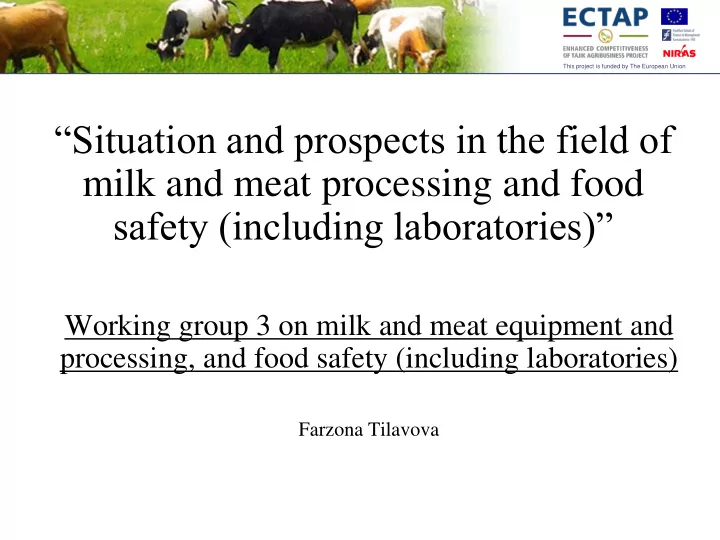

This project is funded by The European Union “Situation and prospects in the field of milk and meat processing and food safety (including laboratories)” Working group 3 on milk and meat equipment and processing, and food safety (including laboratories) Farzona Tilavova
This project is funded by The European Union Food safety issues at the processing level: According Report «Analysis of the food safety situation and development of a regional action plan, Central Asia» Country Report- AFC Consultants International GmbH, CAIConsulting Conclusions: Poor hygienic quality of raw milk leads to a reduction in the shelf life of dairy products, since all bacteria can not be destroyed during pasteurization. Small dairy enterprises are poorly equipped and have poor planning - this is the risk that bacteria will withstand heating or the risk of microbial contamination. Insufficient cleaning and inadequate hygiene procedures in small enterprises is the risk of microbial contamination
This project is funded by The European Union Food safety issues at the processing level : According Report «Analysis of the food safety situation and development of a regional action plan, Central Asia» Country Report- AFC Consultants International GmbH, CAIConsulting Recommended: Establish a system of payment for milk, which will include security parameters, including monitoring of somatic cells. Convincing processors to pay bonuses to suppliers for good quality milk. This will gradually lead to a decrease in the heat treatment of milk for pasteurization purposes (72/73 ° C for 12/13 seconds).
This project is funded by The European Union WHO Report “ WHO estimates of the global burden of foodborne diseases ” https://extranet.who.int/sree/Reports?op=vs&path=/WHO_HQ_ Reports/G36/PROD/EXT/FoodborneDiseaseBurden 4
This project is funded by The European Union Disability Adjusted Life Year ( DALY)* The incidence of food – and water borne diseases can serve as a key indicator of food safety. A relatively well accepted international measure of disease impact combines incidence of illness (morbidity) and of death (mortality into a standardized indicator called the Disability Adjusted Life Year (DALY) * The information is collected from the following source: Food safety and Agricultural Health management in CIS countries: Completing the Transition World bank report no: 40069 – RU. 2007 This document is made available by the World bank in the Russian language; http://siteresources.worldbank.org/INTARD/825826- 1111134598204/21422839/FoodSafetyCIS.pdf 5
This project is funded by The European Union “WHO estimates of the global burden of food borne diseases” WHO results over 10 years (Global estimates, lack of data!) 31 food borne hazards causing 32 diseases 11 diarrhoeal diseases (1 virus, 7 bacteria, 3 protozoa) 7 invasive infectious disease agents (1 virus, 5 bacteria and 1 protozoa) 10 helmints and finally 3 chemicals 600 million food borne diseases, 420,000 deaths in 2010
This project is funded by The European Union Food borne Death Tajikistan EUR B EUR B. Albania; Armenia; Azerbaijan; Bosnia and Herzegovina; Bulgaria; Georgia; Kyrgyzstan; Poland; Romania; Slovakia; Tajikistan; The former Yugoslav ...
This project is funded by The European Union The global burden of foodborne disease (DALYS per 100 000 population) by hazard groups and by sub region, 2010. Tajikistan EUR B
This project is funded by The European Union The global burden of foodborne disease by sub-region (DALYS per 100 Tajikistan 000 population) cause by enteric hazards 2010 EUR B 9
This project is funded by The European Union The relative contribution to the DALY incidence by each agent for each of the sub-regions. This includes enteric protozoa to complete the picture on foodborne parasitic diseases. Tajikistan EUR B 10
This project is funded by The European Union DALY's lost to Diarrheal diseases, 2002 Belarus 31 Ukraine 33 Russian Federation 38 Georgia 38 Moldova 52 Kazakstan 101 Armenia 114 Uzbekistan 147 Azerberjan 440 Kyrgyzstan 512 Turkmenistan 812 Tajikistan 1103 11
This project is funded by The European Union SPS issues for country groups. Group 1 Russian Federation, Group II Armenia, Azerbaijan, Group III Turkmenistan, Ukraine, Kazakhstan and Georgia and Moldova. Uzbekistan, Tajikistan and Belarus Kyrgyzstan Source: WB 40069-RU Food safety situation Good to moderate DALY rate : Good to moderate DALY rate: Moderate to poor DALY rate: 33 -101 31-440 147 -1103 • Perceived increases in zoonotic diseases from small holders farms, Animal health situation Rise in Echnococcosis and other although official databases show decline in tuberculosis and zoonotic diseases brucellosis in Moldova, the Russian Federation and Ukraine • Emergence of HPAI Plant health situation Threat of introduction of pests due to weakened border controls • Good capacity to detect • Weak capacity to detect • Very weak capacity to detect mycotoxin and pesticide mycotoxin and pesticide mycotoxin and pesticide residues. residues. residues • Moderate capacity to deal with • Weak capacity to deal with • Very weak capacity to deal with emergency outbreaks of pests emergency outbreak of pest and emergency outbreaks of pests and diseases diseases and disease (locust, rats) • Moderate plant quarantine • Very weak plant quarantine. (locust, rats) • Weak plant quarantine Capacity to meet require-ments Moderate to low Moderate to low Low in OECD markets for sensitive products Competitiveness in OECD and Moderate to weak Weak Very weak top-end CIS markets 12
This project is funded by The European Union Actual direction Training on Listeria monocytogenus and Enterobacteriaceae according to International best practices to dairy factories and competent authorities
This project is funded by The European Union Actual direction Implementation Codex document on GHP, GMP and HACCP at the processors
This project is funded by The European Union Thank You! ECTAP lstaravshan Street 19 - Apartment 2 734003 Dushanbe Tajikistan ectap@int.fs.de +992 93 511 05 09 15
Recommend
More recommend